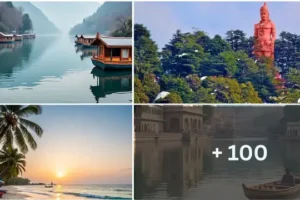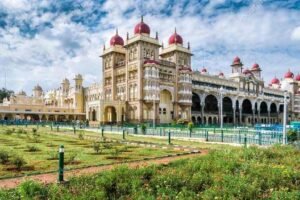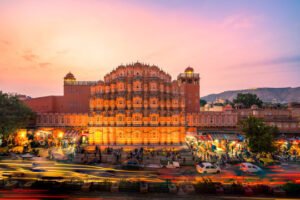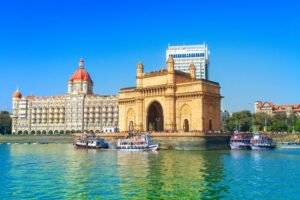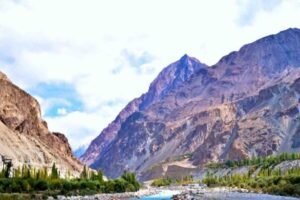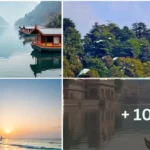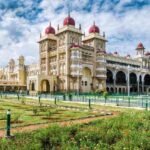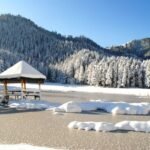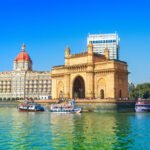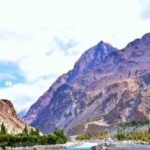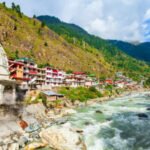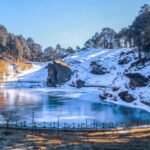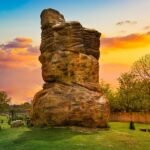Best Places to Visit in Spiti Valley 2025
Best Places to Visit in Spiti Valley: Spiti Valley, nestled in the Himalayas, is a land of stark beauty and serenity. Here are some of the must-visit places in Spiti Valley:
1. Key Monastery:
Key Monastery: Perched atop a hill, Key Monastery is the largest monastery in Spiti Valley. This prominent landmark offers stunning views of the Spiti River and the surrounding landscape. Inside, you’ll find ancient murals, books, and a magnificent Buddha shrine.
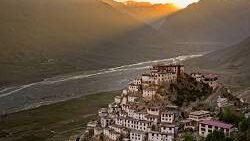
The Key Monastery, also known as Kye Gompa or Kee Gompa, is a Tibetan Buddhist monastery located in the Spiti Valley of Himachal Pradesh, India. It is the largest monastery in the valley and one of the highest in the world, sitting at an altitude of 4,166 meters (13,668 feet) above sea level.
The monastery is believed to have been founded in the 11th century by Dromton, a disciple of Atisha. It is associated with the Gelugpa sect of Tibetan Buddhism, also known as the “Yellow Hat” sect. The Key Monastery is a complex of buildings that includes a prayer hall, assembly hall, kitchen, and living quarters for the monks. The walls of the monastery are adorned with murals depicting Buddhist deities and religious scenes.
The Key Monastery is an important pilgrimage site for Buddhists and a popular tourist destination. Visitors to the monastery can enjoy stunning views of the Spiti Valley and learn about Tibetan Buddhist culture. Here are some things to know if you plan to visit Key Monastery:
- How to Get There: The Key Monastery is located about 12 kilometers north of Kaza, the main town in Spiti Valley. You can reach the monastery by taxi, jeep, or motorbike. The road to the monastery is steep and winding, so it is important to be a confident driver.
- Best Time to Visit: The Spiti Valley is a high-altitude region, so the weather can be extreme. The best time to visit the Key Monastery is from May to September, when the temperatures are mildest. However, it is important to be aware that the Spiti Valley can be quite crowded during peak tourist season.
- What to Wear: Visitors to the Key Monastery should dress modestly. Long pants and shirts with sleeves are recommended. It is also important to wear shoes that are comfortable for walking on uneven terrain.
- Accommodation: There are a few guesthouses located near the Key Monastery. However, it is also possible to stay overnight at the monastery itself. Visitors who are interested in staying at the monastery should contact the monastery administration in advance.
- Monastery Etiquette: When visiting the Key Monastery, it is important to be respectful of the monks and their religion. Visitors should avoid talking loudly or making disruptive noises. It is also customary to remove one’s shoes before entering the prayer hall.
2. Chandratal Lake:
Chandratal Lake: This mesmerizing horseshoe-shaped lake, nestled at an altitude of over 4,300 meters, is known for its color-changing waters. The lake reflects the sky, appearing blue on a clear day and silvery under a full moon. Chandratal Lake is a popular destination for trekking and camping.

- Location: Spiti Valley in Himachal Pradesh, India. It is around 6 km away from Kunzum Pass.
- Altitude: 4,300 meters (14,100 ft)
- Origin of Name: The lake gets its name from its crescent shape, which resembles the moon. “Chandra” means “moon” and “taal” means “lake” in Hindi.
The turquoise waters of the lake are surrounded by barren mountains that create a dramatic and otherworldly landscape. The lake is a popular spot for trekking and camping, and it is also a destination for those who simply want to experience the beauty of the Himalayas.
Here are some things to know if you’re planning a trip to Chandratal Lake:
- How to Get There: The Spiti Valley is a remote region, and there is no public transportation to Chandratal Lake. The most common way to reach the lake is to hire a jeep from Manali or Kaza. The roads to the lake can be rough and treacherous, so it is important to be an experienced driver or hire a reputable driver.
- Best Time to Visit: The Spiti Valley is a high-altitude region, so the weather can be extreme. The best time to visit Chandratal Lake is from July to September, when the temperatures are mildest and the lake is accessible. However, it is important to be aware that the Spiti Valley can be quite crowded during peak tourist season.
- What to Wear: Visitors to Chandratal Lake should dress warmly, even in the summer. The temperatures at the lake can drop well below freezing at night, and there is always the chance of snow. It is also important to wear sturdy shoes that are good for hiking.
- Accommodation: There are a few campsites located near Chandratal Lake. However, it is important to be aware that camping at high altitudes can be dangerous, especially for those who are not acclimated to the conditions. If you are not experienced in camping at high altitudes, it is best to stay in a guesthouse in Kaza or Manali.
- Permits: A permit is required to visit Chandratal Lake. Permits can be obtained from the District Commissioner’s office in Spiti or online.
3. Kunzum Pass:
Kunzum Pass: This scenic mountain pass, located at an altitude of over 4,500 meters, is the gateway to Spiti Valley. The pass offers breathtaking views of the Himalayas and the surrounding valleys. Be aware that due to high altitude, Kunzum Pass can be treacherous, especially during winters.

The Kunzum Pass, also known as Kunzum La, is a high mountain pass in the eastern Kunzum Range of the Himalayas . It connects the Lahaul and Spiti valleys in Himachal Pradesh, India. Located at an elevation of 4,551 meters (14,931 ft), it is one of the highest motorable mountain passes in the country.
The Kunzum Pass is a popular spot for tourists and adventurers. It offers stunning views of the surrounding mountains, including the Bara-Shigri Glacier, the second longest glacier in the world. The pass is also home to the Kunzum Mata temple, a shrine dedicated to the goddess Durga. Many bikers and trekkers visit the pass to experience the challenging terrain and the breathtaking scenery.
The most convenient way to reach Kunzum Pass from Mandi is by car. Here’s the route:
- Take the NH505 eastwards out of Mandi.
- Continue on NH505 for about 260 kilometers (162 miles) until you reach Aut.
- From Aut, take the SH22 towards Kullu.
- Continue on SH22 for about 80 kilometers (50 miles) until you reach Kullu.
- From Kullu, take the NH21 towards Manali.
- Continue on NH21 for about 90 kilometers (56 miles) until you reach Manali.
- From Manali, take the Leh-Manali Highway towards Keylong.
- Continue on the Leh-Manali Highway for about 130 kilometers (81 miles) until you reach Batal.
- From Batal, take the Spiti Valley Road towards Kunzum Pass.
The total distance from Mandi to Kunzum Pass by car is about 640 kilometers (398 miles) and the journey time can take up to 16 hours depending on road and weather conditions. Be aware that the road conditions can be challenging, with steep climbs, narrow sections, and loose gravel. It’s important to be an experienced driver and to drive cautiously. Also, be sure to check the weather conditions before you go, as the pass can be closed due to heavy snowfall.
Here are some things to do in Kunzum Pass:
- Visit the Kunzum Mata temple and seek blessings for a safe journey.
- Take in the panoramic views of the Himalayas.
- Go for a short trek to explore the surrounding area.
- Spot some of the high-altitude wildlife, such as marmots, ibex, and snow leopards.
If you are planning a trip to Kunzum Pass, be sure to check the weather conditions before you go. The pass is typically closed from November to May due to heavy snowfall. The best time to visit is from June to September when the weather is clear and the roads are open.
4. Pin Valley National Park:
Pin Valley National Park: A haven for nature lovers, Pin Valley National Park is home to a variety of flora and fauna, including the endangered snow leopard and the Asiatic ibex. The park also offers stunning scenery, with snow-capped mountains, glaciers, and meadows.
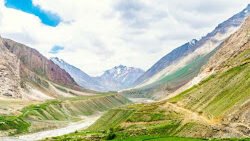
Pin Valley National Park is a national park located in the Spiti Valley, in the Lahaul and Spiti district of Himachal Pradesh, India. It is the only cold desert national park in India . Established in 1987, the park encompasses an area of 675 sq km as a core zone and 1150 sq km as a buffer zone.
The park is a treasure trove of biodiversity, with a unique ecosystem that is home to a variety of flora and fauna. The park’s high altitude and cold desert climate create a challenging habitat for many species, but those that have adapted to these conditions thrive. Some of the animals found in the park include the elusive snow leopard, the Himalayan ibex, the red fox, the marmot, and the lammergeier vulture. The park is also home to a variety of birds, including the chukar partridge, the Himalayan snowcock, and the Tibetan goose.
There are two main routes to reach Pin Valley National Park:
- Summer Route (Open from July to October): This route goes via Kullu – Manali – Rohtang Pass – Kunzum La to Kaza and Pin Valley.
- Winter Route (Open from April to November): This route goes via Shimla – Tapri – Nako – Tabo to Kaza or Pin Valley.
From Kaza, the Pin Valley National Park lies 32 km above and 10 km away, which needs to be covered on foot.
5. Dhangkar Monastery:
Dhangkar Monastery: This ancient monastery, perched on a clifftop, offers panoramic views of the Spiti Valley. Dhangkar Monastery is famous for its unique architecture and its collection of centuries-old Buddhist thangkas.

Dhangkar Monastery, also known as Dhangkar Gompa, is an ancient Buddhist monastery perched on a clifftop in the Spiti Valley of Himachal Pradesh, India. It’s one of the most captivating landmarks of the valley, offering stunning views of the surrounding landscape.
The monastery is believed to be over 1,000 years old, with some sources suggesting it was founded around 1000 AD by Lama Lha-od. In addition to being a religious center, Dhankar Monastery also served as a fort in the past, due to its strategic location.
Here are some interesting facts about Dhankar Monastery:
- It is located at an elevation of over 3,800 meters (12,467 ft).
- The monastery is associated with the Gelug school of Tibetan Buddhism.
- Dhankar Gompa was included in the 2006 World Monuments Fund list of 100 Most Endangered Sites.
- A nonprofit group, Dhangkar Initiative, is working on its conservation.
If you are planning a visit to Spiti Valley, Dhankar Monastery is a must-see. The monastery is open to visitors, and you can explore its various chambers, prayer halls, and even a small museum. The views from the top are simply breathtaking.
There are a few ways to reach Dhankar Monastery, depending on your budget and travel style.
- By Car:This is a great option if you want the freedom to explore Spiti Valley at your own pace. The drive from Manali to Kaza, via the Rohtang Pass, is an adventure in itself. Just make sure to have a permit to drive on the Rohtang Pass . From Kaza, it’s a short drive to Dhankar Monastery. The roads in Spiti Valley can be challenging, especially at high altitudes. Make sure your car is in good condition and you are an experienced driver before attempting this route.
- By Taxi: You can hire a taxi from Manali or Shimla to Dhankar Monastery. This is a more expensive option than taking the bus, but it is also more convenient. Taxis can be hired for the entire round trip, or you can hire them one way from Kaza to Dhankar.
- By Bus: Buses run from Manali and Shimla to Kaza. From Kaza, you can take another bus to a place called Schichling, which is located on the main road between Kaza and Tabo. From Schichling, you can either hire a taxi to Dhankar Monastery, hitchhike, or trek the 8 kilometers to the monastery. Be aware that public transport options in Spiti Valley are limited, especially outside of peak season.
Here are some additional things to keep in mind when planning your trip to Dhangkar Monastery:
- The best time to visit Spiti Valley is from June to September. The weather is pleasant during these months, and the roads are usually open. However, keep in mind that this is also the peak tourist season, so prices will be higher and there will be more crowds.
- Dhankar Monastery is located at a high altitude (over 3,800 meters). Be sure to acclimatize yourself to the altitude before visiting the monastery. This means spending a few days in a lower altitude place like Kaza before making the climb to Dhankar.
- Spiti Valley is a remote region with limited amenities. Be sure to pack plenty of food, water, and supplies before you go. There are a few shops in Dhankar village, but they have a limited selection of items.
6. Tabo Monastery:
Tabo Monastery: This UNESCO World Heritage Site is one of the oldest monasteries in India. The monastery is known for its beautiful murals and its collection of Buddhist texts.

The Tabo Monastery, also known as the Ajanta of the Himalayas, is the oldest continuously operating Buddhist enclave in both India and the Himalayas . It was founded in 996 CE in the Spiti Valley of Himachal Pradesh, northern India by Rinchen Zangpo, a Tibetan Buddhist lotsawa (translator) on behalf of the king of the western Himalayan Kingdom of Guge, Yeshe-Ö.
The monastery is situated in the arid and cold Spiti Valley, on the left bank of the Spiti River, at an altitude of 3,050 metres (10,010 ft). Unlike many monasteries in the region which are perched on hillsides, Tabo Monastery rests on the valley floor. The region was historically part of Tibet.
The Tabo Monastery complex comprises nine temples, four stupas, 23 chortens (hemispherical structures containing relics), a monks’ residence and a large collection of frescos. The murals depict stories from the Buddhist pantheon, making Tabo Monastery a treasure trove of Buddhist art. The murals are made from natural pigments and dyes, and the vivid colours and artistic finesse continue to amaze visitors today. The monastery is an important pilgrimage site for Buddhists.
There are no airports or train stations in Tabo. Here’s how you can reach Tabo Monastery. Road is the most preferred way to reach Tabo Monastery. You can either hire a taxi or take a bus.
- From Manali: This route is around 231.1 kilometers and takes approximately 8 to 10 hours. The route takes you through the scenic Kunzum Pass.
- From Shimla: This route is longer, around 463 kilometers and takes 18 to 20 hours. You will need to reach Reckong Peo from Shimla and then take a bus to Kaza. From Kaza, Tabo Monastery is just an hour’s drive away.
Here are some things to keep in mind when traveling to Tabo by road:
- The roads in Spiti Valley can be treacherous, especially during the winter months (October to April/May) and during the monsoon season (August). Roads may be closed due to landslides.
- It’s best to check the road conditions before you travel, especially if you are planning on driving yourself.
- You can hire a taxi from Manali, Shimla, or Reckong Peo.
- There is only one bus that runs between Reckong Peo and Tabo (heading to Kaza) starting from the Reckong Peo bus stand at 6:30 AM.
7. Kibber Village:
Kibber Village: The highest village in India, Kibber Village is a charming hamlet located at an altitude of 4,270 meters. This village offers stunning views of the Himalayas and is a popular spot for trekking and mountain biking. Kibber is also known for its traditional Buddhist culture and its yak cheese.

The landscape surrounding Kibber Village is a cold desert, with picturesque mountains, barren landscapes, and pockets of green meadows. The area is known for its resemblance to Ladakh and Tibet, and Tibetan Buddhism is the primary religion practiced here. This is why Spiti Valley is sometimes referred to as “Little Tibet”.
Here are some of the things Kibber Village is known for:
- Monasteries and Temples: There are many popular monasteries and temples that you can visit in Kibber.
- Kibber Wildlife Sanctuary: This sanctuary is located close to the village and is home to many animals that have adapted to the snowy environment, including ibex, blue sheep, red fox, Tibetan woolly hare, Himalayan wolf, lynx, pika, Tibetan wild ass, and even snow leopards.
- Adventure Activities: Kibber is a popular destination for adventure seekers, with trekking and mountaineering being some of the main attractions. One popular destination for trekking is Dandmachan Peak.
- Highest Motorable Road: As mentioned before, Kibber holds the distinction of being the highest motorable village in the world. This means you can drive or ride a motorbike to the village and enjoy the stunning views.
- Highest Post Office: Located in Kibber Village is the world’s highest post office. This makes it a popular stop for visitors who want to send a postcard with a unique postmark.
- Chicham Bridge: This bridge is the highest man-made bridge in Asia and is located near Kibber Village.
Reaching Kibber Village requires some planning due to its remote location. There is no air or train connectivity to Kibber, so you’ll need to travel by road. Here’s how to reach Kibber Village:
By Road:
This is the most common way to reach Kibber. You’ll need to make your way to Kaza, the sub-divisional headquarters of Spiti Valley. Here are two options to get to Kaza:
- From Manali:This is the most popular route, though it can be challenging due to high mountain passes. The distance from Manali to Kaza is about 200 kilometers, and it takes 10-12 hours to complete the journey by jeep or taxi.
- From Shimla:This route is longer than the route from Manali, at about 460 kilometers. The travel time can take up to 16 hours by bus or taxi.
Once you reach Kaza:
- Local buses operate between Kaza and Kibber with a travel time of about 1-1.5 hours. Buses run once or twice a day.
- You can also hire a taxi or jeep for a more private and flexible journey.
Things to Consider:
- Spiti Valley and Kibber Village are located at high altitudes, so be sure to acclimatize yourself before you go. This will help to avoid altitude sickness.
- The roads to Spiti Valley can be treacherous, especially during the winter months. Be sure to check the road conditions before you travel.
- Spiti Valley is a remote location with limited amenities. Be sure to pack accordingly and bring enough supplies.
Here are some additional tips for reaching Kibber Village:
- The best time to visit Kibber Village is between June and September when the weather is pleasant.
- If you are planning to trek in the Spiti Valley, be sure to hire a qualified guide.
- Be sure to obtain a permit to visit Spiti Valley. Permits can be obtained online or from the Deputy Commissioner’s office in Shimla or Recong Peo.
Conclusion:
- Spiti Valley leaves an indelible mark on the soul. It’s a place that challenges you, humbles you, and ultimately, inspires you.
- As I leave Spiti Valley behind, I carry a piece of its magic with me – a reminder of the beauty and resilience of nature, and the warmth of its people.
How to reach Spiti Valley?
Spiti Valley cannot be accessed via trains or flights. You can only reach Spiti Valley by road. There are two routes to reach Spiti Valley by road. One is via Manaliwhile the other is via Shimla .The Shimla route passes via Kinnaur valley and you get to traverse through the Hindustan Tibet Highway on this route. The distance from Shimla to Kaza is approx 419 Kilometers and it takes more than 10 hours for you to reach Spiti via Shimla.
Do I need a permit to enter Spiti Valley?
Yes, you do need a permit to enter Spiti Valley. For non-Indian nationals, you will need to obtain an Inner Line Permit. You can get these on the day from Reckong Peo through an expedited service or you can apply beforehand online.
When is the best time to visit Spiti Valley?
The best time to visit Spiti Valley is from June to September. During this time, the weather is pleasant and the roads are open. However, it is also the peak tourist season, so expect crowds. The shoulder seasons (April-May and October-November) can be good times to visit as well, with fewer crowds and pleasant weather. However, some higher altitude passes may be closed during these times.
What should I pack for a trip to Spiti Valley?
Be sure to pack warm clothes, including thermals, jackets, gloves, and a cap, for the high altitude cold. Sunscreen, sunglasses, and a hat are also essential for the strong sun. Since water sources can be scarce in Spiti Valley, it’s wise to bring a reusable water bottle.
Is Spiti Valley safe to visit?
Spiti Valley is a safe place to visit. However, it’s important to be aware of the high altitude and take precautions against altitude sickness.
Where to stay in Spiti Valley?
There are a variety of homestays, guesthouses, and hotels available in Spiti Valley, particularly in the larger villages like Kaza and Kibber.
What are some of the things to do in Spiti Valley?
There are many things to see and do in Spiti Valley, including visiting ancient monasteries, hiking in the Himalayas, and exploring the local villages.

